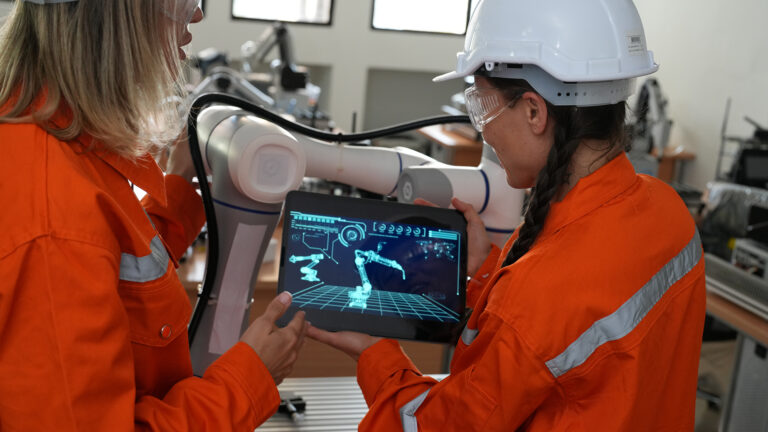What is wifi?
This abstract concept, sometimes difficult to understand, is actually an evolution of technologies such as radio, satellite TV and cellular telephony.
These are radio signals that go between two or more points. To function at a minimum, wifi requires two elements: AP (access point or access point, which is the combination of radios with antennas) and the device to be connected.
These signals work in three frequency ranges: 2.4, 5 and 6 Gigahertz (GHz).
But what do these numbers mean?
The 2.4 GHz frequency has three usable channels and has the longest range (i.e., it can pass through the walls of a house or office). Channels are small spaces in the frequencies dedicated to transmission. A simple way of looking at it is to imagine them as a call, with two or more participants: they will not hear what is going on in other calls (other channels), which are separated to avoid interference.
Due to this limited amount of channels, it is easily saturated, so it is usually not feasible to use it in our phones or laptops, although it is useful for things that do not need much speed, such as controlling smart devices in the home. For example: air conditioners, lights and other elements of the internet of things.
5 GHz is the most widely used today, with up to 25 channels. Because of the way frequencies work, the higher the frequency, the harder it is to pass through obstacles, but what you lose in range you gain in speed: it is several times faster than 2.4 GHz and reduces interference problems.
Finally, in the 6 GHz range we find the most recent one: it came to the market in 2022 with up to 59 new channels. It has the same limitations as the 5 GHz frequencies. There are still few devices that use it, since only those with 6E wifi can do so, but it is the option that will lead wifi networks in the coming years.
How did wifi 6E come about and what is it all about?
This name arose from an improvement in the way we refer to wifi technologies, also known as WLAN (Wireless LAN).
Previously, we only used what the WiFi Alliance (an organization dedicated to the standardization of its trademark wifi, one of the most valued in the wireless communications market) and the Institute of Electrical and Electronics Engineers established in their standards, which involved naming these types of networks as "802.11" followed by letters identifying the technology (e.g., "802.11n"). This made it difficult for users to understand which was best for their connection needs.
In this way, new names were created that were more accessible to users:
- Wifi 4 - 802.11n: works in the 2.4 and 5 GHZ frequencies.
- Wifi 5 - 802.11ac wave 1 and wave 2: works only on the 5 GHz frequency, allowing devices that only support 2.4 GHz to connect to wifi 4.
- Wifi 6 and 6E - 802.11ax: works in 2.4 and 5 GHz, with the novelty that the 6E adds the 6 GHz frequency. This triples the number of total channels that can be used. In general, the main improvement over Wi-Fi 5, beyond the channels, lies in the use of technologies that were inspired by cellular telephony to handle two-way communication of multiple devices simultaneously. Known by its acronym in English as DL/UL MU-MIMO (which refers to download/upload multiple user multiple input multiple output), something that previously could only be done in download. This results in shorter response time and higher speed for all connected terminals.
Channels and interference: what are they and how to manage them?
Let's go back to the analogy of channels and calls. Suppose that in a call one person tries to talk at the same time as the other; it becomes complicated or impossible to understand each other. Interference applied to wifi works the same way: if one transmits, the others stop transmitting. This happens in such small periods of time (milliseconds) that we do not notice it, but the more people need to talk, the slower and more complex communication becomes. The 2.4 GHz networks are the ones that suffer the most from this phenomenon with their scarce three channels: all of them must be divided between only three "calls".
To avoid interference, it is recommended that you do not connect to 2.4 GHz networks (when possible), separate SSIDs (wifi names) on the frequencies you use to avoid equipment connecting where you don't want it to, and use enterprise-grade equipment (i.e., those for professional networks, such as Alcatel-Lucent Enterprise, Meraki, Cisco, Fortigate or Aruba) whenever you can.
Interference does not only come from other networks and equipment; if there are multiple access points in the same network transmitting on the same frequency as others, it is called self-interference.

The stubborn devices that keep us awake at night
In wifi networks, the client (in this case, the device) is king. No matter what you do, if the client does not want to connect to e.g. wifi 5, you have nothing to do but "suggest" that it switch. This is notorious, for example, in laptops that tend to connect more to 2.4 networks than to 5 GHz. We see it in Apple's MacBook, while cell phones and tablets are better optimized and tend to connect to 5 GHz whenever they can.
In addition, there is a serious problem between devices and it is roaming (changing antennas), something that phones and tablets do without problems, while laptops stay connected even with low signal or having better options where to connect, this is known as "Sticky Client".
As with interference, one way to manage the connections of these devices is to use enterprise-class networks, which have better processors and antennas, as well as specific uses (such as for outdoor areas). But where they shine the most is in their intelligence to select which channels to use at each site, distribute clients and suggest that, for example, those reluctant laptops switch antennas or frequencies, for a better end-user experience.
This allows us to have specialized networks for warehouse automation or for hotels with hundreds of rooms, working together for the benefit of the customer, something that home-based solutions cannot do.
How can we improve the design of this type of network?
Less is more: when there are limited channels, the more equipment you have, the more self-interference you will have, so it is always better to place one larger piece of equipment in a strategic position than to use three or four small pieces of equipment to fill in for it.
Wi-Fi is an essential technology in our daily lives. Understanding these points allows us to get the most out of it from the design to its day-to-day operation and turn "this must work by magic" into something tangible and real.
By:
Emmanuel Sánchez, Product Line Specialist at Networking & Security.
Emmanuel has a degree in Telecommunications Engineering and a diploma in Telecommunications Management.
He holds international certifications such as Cisco Certified Specialist Enterprise Core (CCNS), Cisco Certified Network Associate (CCNA), Certified Meraki Network Associate, ACFE OmniSwitch, LAN Access Switching and ACSE OmniAccess Stellar WLAN Enterprise.
In addition, he completed multiple specializations in areas such as fiber optics, DWDM, SDH, grounding systems and radio links.



